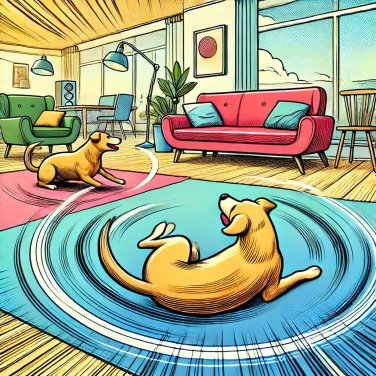Dogs circle around before lying down to create a comfortable spot to lay. This behavior dates back to their wild ancestors who would trample the grass to make it softer and to chase away parasites.

This behavior comes straight from the wild ancestors of dogs. Before sleeping, they had a habit of circling around to flatten the vegetation and eliminate any disturbances like insects or snakes. It was also a way to ensure that no danger was hiding around them. Today, even if your dog sleeps comfortably at home, this ancestral reflex persists, coded in their DNA. It’s a kind of little instinctive ritual for preparing for sleep.
By turning in circles, your dog is simply checking that there are no dangers before settling down. This reflex dates back to when dogs still lived in packs in the wild: by trampling the area, they would scare away small harmful creatures, like insects or even certain snakes, while subtly marking their territory. This circular movement allows your dog to ensure that it has full control over its environment and that no intruder has entered its personal space. It is a kind of security ritual: your dog knows it can finally sleep peacefully after conducting this quick survey.
Before lying down, dogs turn around several times to flatten the grass or pack their blanket to create a cozy and comfortable space. In doing these little turns, they also check that the surface doesn't hide any disturbing elements like stones or twigs. Many dogs seek the spot that best fits the shape of their body, allowing them an ideal and relaxing resting position. This turning ritual is therefore a practical way for the dog to quickly and efficiently set up its sleeping corner for optimal sleep.
If the place is cold or damp, dogs often turn in circles to better position their bodies in a well-protected corner. Conversely, in very hot weather, this behavior helps to uncover a cool surface beneath them by clearing away vegetation or superficial warm soil. The state of the ground also matters: when it’s uncomfortable, annoying, or full of stones, they turn more to dig out a softer spot or remove what disturbs them. Even if your dog has a cozy bed at home, you’ll notice that he turns less, but still maintains this innate reflex, an ancient legacy from times when sleeping peacefully and comfortably was far from guaranteed.
Every dog has its little habits: some will spin around for a long time before lying down, while others will simply do one or two quick turns and hop into bed! It largely depends on the breed, the temperament, and their past experiences. More anxious or wary dogs tend to spin more, just to make sure everything is in order (a bit of a fuss, really!). In contrast, those that are more relaxed or confident settle down faster, without much ceremony. Age also plays a role: an older dog, with some joint pain, will often spin less or avoid this ritual if it's too uncomfortable. In short, every pup is different, and their habits before napping are too!
Dogs are not the only ones to adopt this ritual before resting. Other mammals like wolves and foxes exhibit the same behavior, thereby reinforcing the idea of an ancestral and instinctive origin.
The act of circling also helps dogs check that their bedding is free of insects and any bothersome objects, thereby improving their comfort while sleeping.
A scientific study conducted in 2013 suggests that dogs may circle before sleeping to align themselves with the Earth's magnetic field. Although this remains debated, this fascinating hypothesis continues to be explored by researchers.
Dogs that frequently circle before lying down sometimes show signs of stress or anxiety. Observing changes in this behavior could help you better understand your pet's emotional well-being.
To help your dog feel comfortable, provide a calm and cozy space with a soft cushion or a rug suitable for its size. Also, make sure to avoid noisy or bright disturbances and respect its natural sleeping habits.
Although all dogs can exhibit this instinctive behavior, some dogs with older or closer wolf ancestry may be more inclined to circle before settling down. Similarly, more anxious dogs or those highly sensitive to their environment may also circle more frequently.
Scratching and turning are related to instinctive behaviors inherited from wild dogs. Scratching used to help prepare a comfortable shelter, release familiar reassuring scents, and remove any potential bothersome objects or parasites.
If your dog circles a few times before lying down, that is completely normal. However, if they circle excessively for a long period without lying down, it could be a sign of a problem such as anxiety, joint pain, or neurological issues. In this case, a veterinary consultation is recommended.
Yes, absolutely! This behavior is instinctive in dogs and has its origins in their wild ancestors, who would circle around to ensure their safety, mark their territory, and create a comfortable place to sleep.

No one has answered this quiz yet, be the first!' :-)
Question 1/5